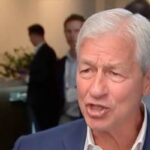We adhere to strict standards of editorial integrity to help you make decisions with confidence. Some or all links contained within this article are paid links.
President Donald Trump says tariffs could deliver a financial windfall for everyday Americans — by wiping out their income taxes.
“When tariffs cut in, many people’s income taxes will be substantially reduced, maybe even completely eliminated,” Trump declared in a Truth Social post on April 27. “Focus will be on people making less than $200,000 a year.”
That’s a bold promise, especially considering that only 14.4% of U.S. households earned more than $200,000 annually in 2023, according to Census Bureau data. In other words, if Trump’s vision holds true, the vast majority of Americans would pay no income tax at all.
Don’t miss
- I’m 49 years old and have nothing saved for retirement — what should I do? Don’t panic. Here are 5 of the easiest ways you can catch up (and fast)
- Gain potential quarterly income through this $1B private real estate fund — even if you’re not a millionaire. Here’s how to get started with as little as $10
- You’re probably already overpaying for this 1 ‘must-have’ expense — and thanks to Trump’s tariffs, your monthly bill could soar even higher. Here’s how 2 minutes can protect your wallet right now
But don’t celebrate just yet. While Trump is optimistic, experts say the math simply doesn’t add up.
Economists Erica York and Huaqun Li of the Tax Foundation were blunt, explaining in a response on April 28 that “the individual income tax raises more than 27 times as much revenue as tariffs currently do,” and “even eliminating income taxes for a subset of taxpayers, such as those earning $200,000 or less, would require significantly higher replacement revenues than tariffs could generate.”
They estimate that the tariffs Trump has imposed and scheduled as of April 2025 would generate nearly $167 billion in new federal tax revenue in 2025 — covering less than 25% of the cost of eliminating income taxes for people earning below $200,000.
While Trump’s proposal faces serious doubts, policy changes aren’t the only route to lowering tax bills. Here are two powerful assets that everyday investors can use to their advantage.
Stocks
Scott Galloway, professor of marketing at New York University’s Stern School of Business, once said that if you’re trying to build wealth, you have “an obligation to pay as little tax as possible.”
His advice? Keep it simple: “You buy stocks, you never sell them, you borrow against them.”
Galloway broke it down with an example: “You own $100 in Amazon stock. You need money to buy something. Instead of selling the stock, and let’s say it’s gone up 50% … You would have to realize a capital gain and pay long-term capital gains [tax] on that $50 gain. No, just borrow against it and let the stock continue to grow.”
This strategy allows investors to tap into the value of their portfolios without triggering a taxable event. Because capital gains are only taxed when realized, borrowing against appreciated assets lets investors access cash while deferring taxes.
Meanwhile, the investments themselves can continue to grow. And since the interest on the loan is often smaller than the tax bill from a sale, this approach can be a powerful tool for preserving and compounding wealth over time.
Of course, not all investors want to pick individual stocks — and you don’t have to. Warren Buffett, one of the most successful investors of our time, recommends a much simpler path: buying a cross-section of the American economy.
“In my view, for most people, the best thing to do is own the S&P 500 index,” Buffett has stated, meaning invest in an S&P 500 index fund. This straightforward approach gives investors exposure to the top American companies on the stock market, providing diversified exposure without the need for constant monitoring or active trading.
The beauty of this approach is its accessibility — anyone, regardless of wealth, can take advantage of it. Even small amounts can grow over time with tools like Acorns, a popular app that automatically invests your spare change.
Signing up for Acorns takes just minutes: link your cards, and Acorns will round up each purchase to the nearest dollar, investing the difference — your spare change — into a diversified portfolio. With Acorns, you can invest in an S&P 500 ETF with as little as $5 — and, if you sign up today, Acorns will add a $20 bonus to help you begin your investment journey.
Read more: Want an extra $1,300,000 when you retire? Dave Ramsey says this 7-step plan ‘works every single time’ to kill debt, get rich in America — and that ‘anyone’ can do it
Real estate
Real estate has long been a go-to asset for building wealth — and one of the reasons is the generous tax treatment it receives.
When you earn rental income from an investment property, you can claim deductions for a wide range of expenses, such as mortgage interest, property taxes, insurance and ongoing maintenance and repairs.
Real estate investors also benefit from depreciation — a tax deduction that recognizes the gradual wear and tear of a property over time.
Today, you don’t need to be a millionaire or buy property outright to benefit from real estate investing. Crowdfunding platforms like Arrived, for instance, offer an easier way to get exposure to this income-generating asset class.
With Arrived, you can invest in shares of rental homes with as little as $100, all without the hassle of mowing lawns, fixing leaky faucets or handling difficult tenants.
The process is simple: browse a curated selection of homes that have been vetted for their appreciation and income potential. Once you find a property you like, select the number of shares you’d like to purchase, and then sit back as you start receiving rental income deposits from your investment.
Another option is Homeshares, which opens the door to the $30-plus trillion U.S. home equity market — a space that was once reserved almost exclusively for institutional investors. With a minimum investment of $25,000, accredited investors can gain direct exposure to hundreds of owner-occupied homes in top U.S. cities through their U.S. Home Equity Fund — without the headaches of buying, owning or managing property.
With risk-adjusted target returns ranging from 14% to 17%, this approach provides an effective, hands-off way to invest in owner-occupied residential properties across regional markets.
What to read next
- Millions of Americans now sit on a stunning $35 trillion in home equity — here’s 1 new way to invest in responsible US homeowners while targeting a 14%-17% IRR
- Robert Kiyosaki warns of a ‘Greater Depression’ coming to the US — with millions of Americans going poor. But he says these 2 ‘easy-money’ assets will bring in ‘great wealth’. How to get in now
- Here are 5 ‘must have’ items that Americans (almost) always overpay for — and very quickly regret. How many are hurting you?
This article provides information only and should not be construed as advice. It is provided without warranty of any kind.








